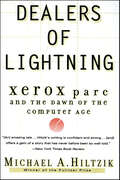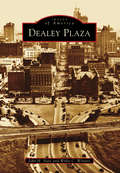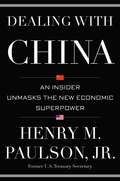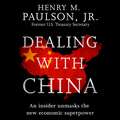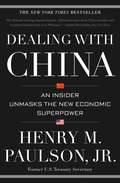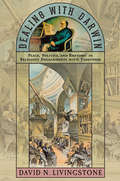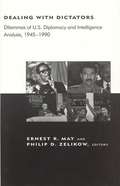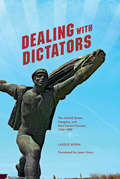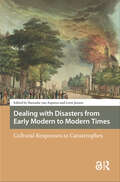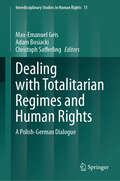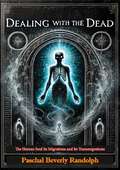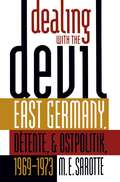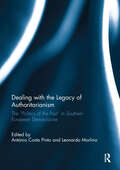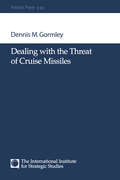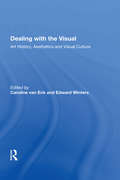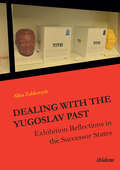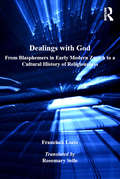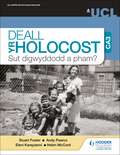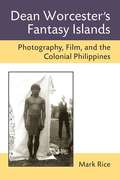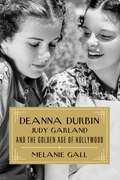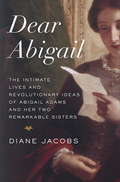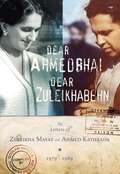- Table View
- List View
Dealers of Lightning: Xerox PARC and the Dawn of the Computer Age
by Michael A. HiltzikThe Pulitzer Prize-winner’s classic account of the legendary research lab that gave rise to the Digital Age.In the 1970s and ‘80s, Xerox Corporation brought together a brain-trust of engineering geniuses dubbed PARC (Palo Alto Research Center). This brilliant group created several monumental innovations that triggered a technological revolution, including the first personal computer, the laser printer, and the graphical interface (one of the main precursors of the Internet). And when these breakthroughs were rejected by the corporation, these determined inventors turned their ideas into empires that changed the world.Based on extensive interviews with the scientists, engineers, administrators, and executives who lived the story, Dealers of Lightning details PARC’s rise from humble beginnings to a hothouse for ideas. It also shows why Xerox was never able to grasp the cutting-edge innovations PARC delivered. Michael A. Hiltzik offers an unprecedented look at the ideas, the inventions, and the individuals that propelled Xerox PARC to the frontier of techno-history—and the corporate machinations that almost prevented it from achieving greatness.
Dealey Plaza
by John H. Slate Willis C. WintersDealey Plaza is famous for many things, both locally and nationally. Considered "the front door of Dallas," the park rests on a bluff near the Trinity River, where Dallas's founder, John Neely Bryan, identified a natural low-water crossing in 1841. This ford was the site of Bryan's cabin and was also the site of the first ferry and bridge over the Trinity River. Home to several Dallas County buildings and other historic structures, Dealey is not just the birthplace of Dallas; it is also the site of Dallas's first large-scale city planning solution, a traffic diverting triple underpass, and a beautiful downtown park built in the 1930s. The park was launched into national history when Pres. John F. Kennedy was assassinated here on November 22, 1963. Today, the site is visited by over two million annually. To preserve Dealey Plaza and its surrounding buildings, the federal government designated it a National Historic Landmark District in 1993.
Dealing With China: An Insider Unmasks The New Economic Superpower
by Henry M. PaulsonDEALING WITH CHINA takes the reader behind closed doors to witness the creation and evolution and future of China's state-controlled capitalism.<P><P> Hank Paulson has dealt with China unlike any other foreigner. As head of Goldman Sachs, Paulson had a pivotal role in opening up China to private enterprise. Then, as Treasury secretary, he created the Strategic Economic Dialogue with what is now the world's second-largest economy. He negotiated with China on needed economic reforms, while safeguarding the teetering U.S. financial system. Over his career, Paulson has worked with scores of top Chinese leaders, including Xi Jinping, China's most powerful man in decades. <P> In DEALING WITH CHINA, Paulson draws on his unprecedented access to modern China's political and business elite, including its three most recent heads of state, to answer several key questions:<P> * How did China become an economic superpower so quickly?<P> * How does business really get done there?<P> * What are the best ways for Western business and political leaders to work with, compete with, and benefit from China?<P> * How can the U.S. negotiate with and influence China given its authoritarian rule, its massive environmental concerns, and its huge population's unrelenting demands for economic growth and security?<P> Written in the same anecdote-rich, page-turning style as Paulson's bestselling memoir, On the Brink, DEALING WITH CHINA is certain to become the classic and definitive examination of how to engage China's leaders as they build their economic superpower.<P> Chosen for Mark Zuckerberg's "A Year of Books"
Dealing with China
by Hank PaulsonDEALING WITH CHINA takes the reader behind closed doors to witness the creation and evolution and future of China's state-controlled capitalism.Hank Paulson has dealt with China unlike any other foreigner. As head of Goldman Sachs, Paulson had a pivotal role in opening up China to private enterprise. Then, as Treasury secretary, he created the Strategic Economic Dialogue with what is now the world's second-largest economy. While negotiating with China on needed economic reforms, he safeguarded the teetering U.S. financial system. Over his career, Paulson has worked with scores of top Chinese leaders, including Xi Jinping, China's most powerful man in decades. In DEALING WITH CHINA, Paulson draws on his unprecedented access to modern China's political and business elite, including its three most recent heads of state, to answer several key questions:How did China become an economic superpower so quickly?How does business really get done there?What are the best ways for Western business and political leaders to work with, compete with, and benefit from China?How can the West negotiate with and influence China given its authoritarian rule, its massive environmental concerns, and its huge population's unrelenting demands for economic growth and security?Written in an anecdote-rich, page-turning style, DEALING WITH CHINA is certain to become the classic and definitive examination of unlocking, building, and engaging an economic superpower.
Dealing with China: An Insider Unmasks the New Economic Superpower
by Henry M. PaulsonNEW YORK TIMES BESTSELLERDEALING WITH CHINA takes the reader behind closed doors to witness the creation and evolution and future of China's state-controlled capitalism. Hank Paulson has dealt with China unlike any other foreigner. As head of Goldman Sachs, Paulson had a pivotal role in opening up China to private enterprise. Then, as Treasury secretary, he created the Strategic Economic Dialogue with what is now the world's second-largest economy. He negotiated with China on needed economic reforms, while safeguarding the teetering U.S. financial system. Over his career, Paulson has worked with scores of top Chinese leaders, including Xi Jinping, China's most powerful man in decades. In DEALING WITH CHINA, Paulson draws on his unprecedented access to modern China's political and business elite, including its three most recent heads of state, to answer several key questions:How did China become an economic superpower so quickly?How does business really get done there?What are the best ways for Western business and political leaders to work with, compete with, and benefit from China?How can the U.S. negotiate with and influence China given its authoritarian rule, its massive environmental concerns, and its huge population's unrelenting demands for economic growth and security?Written in the same anecdote-rich, page-turning style as Paulson's bestselling memoir, On the Brink, DEALING WITH CHINA is certain to become the classic and definitive examination of how to engage China's leaders as they build their economic superpower.
Dealing with Dark Pasts: A European History of Auto-Critical Memory in Global Perspective (Elements in Historical Theory and Practice)
by Itay LotemSince the end of the Second World War, the political rationale to remember the past has shifted from previous focus on states' victories, as these began commemorating their own historical crimes. This Element follows the rise of 'auto-critical memory', or the politics of remembrance of a country's own dark past. The Element explores the idea's gestation in West Germany after the Second World War, its globalisation through initiatives of 'transitional justice' in the 1990s, and present-day debates about how to remember the colonial past. It follows different case studies that span the European continent – including Germany, France, Britain, Poland and Serbia – and places these in a global context that traces the circulation of ideas of auto-critical memory. Ultimately, as it follows the emergence of demands for social and racial justice, the Element questions the usefulness of memory to achieve the goals many political actors ascribe to it.
Dealing with Darwin: Place, Politics, and Rhetoric in Religious Engagements with Evolution (Medicine, Science, and Religion in Historical Context)
by David N. LivingstoneHow was Darwin’s work discussed and debated among the same religious denomination in different locations?Using place, politics, and rhetoric as analytical tools, historical geographer David N. Livingstone investigates how religious communities sharing a Scots Presbyterian heritage engaged with Darwin and Darwinism at the turn of the twentieth century. His findings, presented as the prestigious Gifford Lectures, transform our understandings of the relationship between science and religion.The particulars of place—whether in Edinburgh, Belfast, Toronto, Princeton, or Columbia, South Carolina—shaped the response to Darwin’s theories. Were they tolerated, repudiated, or welcomed? Livingstone shows how Darwin was read in different ways, with meaning distilled from Darwin's texts depending on readers' own histories—their literary genealogies and cultural preoccupations. That the theory of evolution fared differently in different places, Livingstone writes, is "exactly what Darwin might have predicted. As the theory diffused, it diverged." Dealing with Darwin shows the profound extent to which theological debates about evolution were rooted in such matters as anxieties over control of education, the politics of race relations, the nature of local scientific traditions, and challenges to traditional cultural identity. In some settings, conciliation with the new theory, even endorsement, was possible—demonstrating that attending to the specific nature of individual communities subverts an inclination to assume a single relationship between science and religion in general, evolution and Christianity in particular. Livingstone concludes with contemporary examples to remind us that what scientists can say and what others can hear in different venues differ today just as much as they did in the past.
Dealing with Dictators: Dilemmas of U.S. Diplomacy and Intelligence Analysis, 1945-1990
by Ernest R. May Philip D. Zelikow Kirsten Lundberg Robert D. JohnsonAnalysis of the foreign policy dilemmas US leaders have faced in dealings with dictatorships in China, the Congo, Iran, Nicaragua, the Philippines, and Iraq before the Gulf War.
Dealing with Dictators: The United States, Hungary, and East Central Europe, 1942-1989
by Jason Vincz László BorhiDealing with Dictators explores America's Cold War efforts to make the dictatorships of Eastern Europe less tyrannical and more responsive to the country's international interests. During this period, US policies were a mix of economic and psychological warfare, subversion, cultural and economic penetration, and coercive diplomacy. Through careful examination of American and Hungarian sources, László Borhi assesses why some policies toward Hungary achieved their goals while others were not successful. When George H. W. Bush exclaimed to Mikhail Gorbachev on the day the Soviet Union collapsed, "Together we liberated Eastern Europe and unified Germany," he was hardly doing justice to the complicated history of the era. The story of the process by which the transition from Soviet satellite to independent state occurred in Hungary sheds light on the dynamics of systemic change in international politics at the end of the Cold War.
Dealing with Disasters from Early Modern to Modern Times: Cultural Responses to Catastrophes (Disaster Studies)
by Hanneke van Asperen and Lotte JensenDisasters are as much cultural as natural phenomena. For centuries, news about catastrophic events has been disseminated through media such as chronicles, pamphlets, newspapers, poems, drawings, and prints. Nowadays, we are overwhelmed with news about the cataclysmic effects of recent forest fires, floods, and storms. Due to the ongoing climate crisis, extreme weather events will likely have ever greater impacts on our lives. This volume addresses cultural representations of catastrophes such as floods, epidemics, and earthquakes over the centuries. In the past as now, artists and authors try to make sense of disasters, grasp their impact, and communicate moral, religious, or political messages. These creations reflect and shape how people learn and think about disasters that occur nearby or far away, both in time and space. The parallels between past and present underline how this book contributes to modern debates about cultural and creative strategies in response to disasters.
Dealing with Totalitarian Regimes and Human Rights: A Polish-German Dialogue (Interdisciplinary Studies in Human Rights #11)
by Christoph Safferling Max-Emanuel Geis Adam BosiackiThis book delves into the intertwined narratives of Poland and Germany's post-war experiences, shedding light on their shared trauma from World War II and subsequent confrontations with communism. Authored by scholars from Faculty of Law and Administration, University of Warsaw and Law School of Friedrich-Alexander University Erlangen-Nuremberg, it opens a critical dialogue about the nations' efforts to recover from war, dictatorship, and human rights abuses. From constitutional law to criminal justice, the chapters explore diverse facets of their shared history, offering fresh insights and reflections. This collaborative effort culminates in a comprehensive analysis of post-war politics and legal frameworks, providing valuable perspectives on transitional justice and human rights protection. Through meticulous research and interdisciplinary discourse, the book aims to deepen Polish-German friendship, foster academic cooperation, and honor the memory of past generations while envisioning a future rooted in the rule of law, human rights, and peace for both nations and Europe as a whole. Through insightful contributions and meticulous research, it navigates complex legal and political landscapes, providing valuable insights into the challenges and opportunities inherent in navigating the legacies of war, dictatorship, and human rights abuses. It reflects on the profound implications of historical events, such as the Treaty of Versailles and the Nuremberg Trials, on legal and political landscapes. Through detailed examinations of institutional transformations and legal frameworks, it highlights the challenges of confronting past injustices and shaping future trajectories.
Dealing with the Dead: The Human Soul Its Migrations and Its Transmigrations
by Paschal Beverly RandolphDealing with the Dead: The Human Soul, Its Migrations, and Its Transmigrations by Paschal Beverly Randolph is a profound exploration of the mysteries of the human soul, its journey through life and death, and the concept of reincarnation. Written by one of the most enigmatic and influential figures in 19th-century esoteric thought, this book offers readers a unique perspective on life after death and the soul’s eternal quest for growth and understanding.Randolph, a renowned occultist, spiritualist, and mystic, delves into the nature of the soul, exploring its origins, its connection to the divine, and its experiences across multiple lifetimes. Through his deeply reflective and often poetic prose, Randolph examines the soul’s migrations—its passage through different planes of existence—and its transmigrations, or reincarnations, as it seeks to learn, evolve, and ultimately reunite with the source of all creation.Dealing with the Dead is both a philosophical treatise and a spiritual guide, offering insights into the afterlife, the process of death, and the continuity of the soul’s existence beyond the physical realm. Randolph discusses the conditions that influence the soul’s journey, including the moral and spiritual lessons learned in each life, and how these experiences shape its future incarnations.This book also touches on the communication with the departed, offering a compassionate and thoughtful approach to understanding the relationship between the living and the dead. Randolph’s teachings encourage readers to view death not as an end but as a transition, a doorway to new experiences and greater wisdom.Dealing with the Dead is essential reading for those interested in the concepts of reincarnation, spiritualism, and the eternal nature of the soul. Paschal Beverly Randolph’s work continues to inspire and challenge readers to think deeply about the mysteries of life, death, and the spiritual dimensions that lie beyond the material world.This book is a timeless exploration of the soul’s journey, offering comfort, insight, and a deeper understanding of the human experience.
Dealing with the Devil
by M. E. SarotteUsing new archival sources--including previously secret documents of the East German secret police and Communist Party--M. E. Sarotte goes behind the scenes of Cold War Germany during the era of detente, as East and West tried negotiation instead of confrontation to settle their differences. In Dealing with the Devil, she explores the motives of the German Democratic Republic and its Soviet backers in responding to both the detente initiatives, or Ostpolitik, of West Germany and the foreign policy of the United States under President Nixon. Sarotte focuses on both public and secret contacts between the two halves of the German nation during Brandt's chancellorship, exposing the cynical artifices constructed by negotiators on both sides. Her analysis also details much of the superpower maneuvering in the era of detente, since German concerns were ever present in the minds of leaders in Washington and Moscow, and reveals the startling degree to which concern over China shaped European politics during this time. More generally, Dealing with the Devil presents an illuminating case study of how the relationship between center and periphery functioned in the Cold War Soviet empire.
Dealing with the Dragon: A Year in the New Hong Kong
by Jonathan FenbyWhat the new Hong Kong is like.
Dealing with the Legacy of Authoritarianism: The “Politics of the Past” in Southern European Democracies (South European Society and Politics)
by António Costa Pinto and Leonardo MorlinoIn recent years the agenda of how to ‘deal with the past’ has become a central dimension of the quality of contemporary democracies. Many years after the process of authoritarian breakdown, consolidated democracies revisit the past either symbolically or to punish the elites associated with the previous authoritarian regimes. New factors, like international environment, conditionality, party cleavages, memory cycles and commemorations or politics of apologies, do sometimes bring the past back into the political arena.This book addresses such themes by dealing with two dimensions of authoritarian legacies in Southern European democracies: repressive institutions and human rights abuses. The thrust of this book is that we should view transitional justice as part of a broader ‘politics of the past’: an ongoing process in which elites and society under democratic rule revise the meaning of the past in terms of what they hope to achieve in the present.This book was published as a special issue of South European Society and Politics.
Dealing with the Threat of Cruise Missiles: Dealing With The Threat Of Cruise Missiles (Adelphi series)
by Dennis M GormleyHow can the core transatlantic Allies make coalitions more effective? One year on from Kosovo, disparities in the capabilities of the coalition partners, as well as uneven levels of prior coordination, persist. To address these problems will require much greater force planning in peacetime. This stimulating and influential work offers one of the most comprehensive independent assessments to date of the Kosovo campaign, and of the performance of the NATO allies. An important subject area in which there is a great deal of international interest.
Dealing with the Visual: Art History, Aesthetics and Visual Culture (Histories Of Vision Ser.)
by Edward Winters Caroline van EckOne of the issues underlying current debates between practitioners of art history, visual culture and aesthetics is whether the visual is a unique, irreducible category, or whether it can be assimilated with the textual or verbal without any significant loss. Can paintings, buildings or installations be 'read' in the way texts are read or deciphered, or do works of visual art ask for their own kind of appreciation? This is not only a question of choosing the right method in dealing with visual works of art, but also an issue that touches on the roots of the disciplines involved: can a case be made for the visual as an irreducible category of art, and if so, how is it best studied and appreciated? In this anthology, this question is approached from the angles of three disciplines: aesthetics, visual culture and art history. Unlike many existing overviews of visual culture studies, it includes both painting and architecture, and investigates historical ways of defining and appreciating the visual in their own, contemporary terms. Dealing with the Visual will be of great use to advanced students because it offers an overview of current debates, and to graduate students and professionals in the field because the essays offer in-depth investigations of the methodological issues involved and various historical ways of defining visuality. The topics included range from early modern ways of viewing pictures and sixteenth-century views of Palladio's villas in their landscape settings to contemporary debate about whether there is life yet in painting.
Dealing with the Yugoslav Past: Exhibition Reflections in the Successor States
by Alina ZubkovychThis book analyzes the representation of the socialist past in the national history museums of the former Yugoslavia. Through travels to Croatia, Bosnia and Herzegovina, Montenegro, Kosovo, and Macedonia, the study elucidates the process of constructing the national narratives that maintain and legitimize a particular vision of the common past. Cross-national comparison allows for analysis of the democratic development of each state in relation to the politics of memory in the region and the role of political actors in its construction.
Dealings with God: From Blasphemers in Early Modern Zurich to a Cultural History of Religiousness (St Andrews Studies In Reformation History Ser.)
by Francisca LoetzEarly modern European society took a serious view of blasphemy, and drew upon a wide range of sanctions - including the death penalty - to punish those who cursed, swore and abused God. Whilst such attitudes may appear draconian today, this study makes clear that in the past, blasphemy was regarded as a very real threat to society. Based on a wealth of primary sources, including court records, theological and ecclesiastical writings and official city statutes, Francisca Loetz explores verbal forms of blasphemy and the variety of contexts within which it could occur. Honour conflicts, theological disputation, social and political provocation, and religious self-questioning all proved fertile ground for accusations of blasphemy, and her contention - that blasphemers often meant more than they said - reveals the underlying complexity of an apparently simple concept. This innovative approach interprets cases of verbal blasphemy as 'speech actions' that reflect broader political, social and religious concerns. Cases in Protestant Zurich are compared with the situation in Catholic Lucerne and related to findings in other parts of Europe (Germany, France, England, Italy) to provide a thorough discussion of different historical approaches to blasphemy - ecclesiastical, legal, intellectual, social, and cultural - in the Early Modern period. In so doing the book offers intriguing suggestions about what a cultural history of religiousness could and should be. By linking a broad overview of the issue of blasphemy, with case studies from Zurich and Lucerne, this book provides a fascinating insight into a crucial, but often misunderstood aspect of early-modern society. The conclusions reached not only offer a much fuller understanding of the situation in Zurich, but also have resonance for all historians of Reformation Europe.
Deall yr Holocost yn ystod CA3: Sut digwyddodd a pham? (Understanding the Holocaust at KS3: How and why did it happen? Welsh-language edition)
by Andy Pearce Helen McCord Stuart Foster Eleni KarayianniIn 2016 the UCL Centre for Holocaust Education published a landmark study, What do students know and understand about the Holocaust? Almost 10,000 students aged 11 to 18 participated in the research. It was the largest of its kind anywhere in the world. The study indicated that the vast majority of young people found the subject interesting and relevant. However, it also revealed that many students did not have clear knowledge and understanding of the Holocaust.Written in direct response to the findings of the 2016 national study, this textbook significantly improves understanding of the Holocaust by:> Providing you with an appropriate historical overview of key aspects of the Holocaust> Helping you to understand the long-standing hatred of Jews (i.e., the roots of antisemitism)> Deepening your knowledge and understanding of the Holocaust> Encouraging you to challenge common myths and misconceptions (e.g., that Hitler was solely responsible for the Holocaust)> Developing your understanding of key historical concepts (e.g., evidence, interpretation, causation, significance)> Enabling you to answer the big historical question: How and why did the Holocaust happen?> Helping you to appreciate the impact of the Holocaust on ordinary people across Europe> Inviting you to consider the importance of the Holocaust and its significance todayThis textbook is supported by additional materials and teacher guidance notes on the UCL Centre for Holocaust Education website (holocausteducation.org.uk).The original design, development and distribution of this textbook was funded by the Toni Schiff Memorial Fund and the Pears Foundation. The Centre is enormously grateful for their support. The Wiener Holocaust Library also provided considerable assistance in developing the textbook.Please note: This is a Welsh-language edition
Deall yr Holocost yn ystod CA3: Sut digwyddodd a pham? (Understanding the Holocaust at KS3: How and why did it happen? Welsh-language edition)
by Professor Stuart Foster Dr Andy Pearce Dr Eleni Karayianni Helen McCordIn 2016 the UCL Centre for Holocaust Education published a landmark study, What do students know and understand about the Holocaust? Almost 10,000 students aged 11 to 18 participated in the research. It was the largest of its kind anywhere in the world. The study indicated that the vast majority of young people found the subject interesting and relevant. However, it also revealed that many students did not have clear knowledge and understanding of the Holocaust.Written in direct response to the findings of the 2016 national study, this textbook significantly improves understanding of the Holocaust by:> Providing you with an appropriate historical overview of key aspects of the Holocaust> Helping you to understand the long-standing hatred of Jews (i.e., the roots of antisemitism)> Deepening your knowledge and understanding of the Holocaust> Encouraging you to challenge common myths and misconceptions (e.g., that Hitler was solely responsible for the Holocaust)> Developing your understanding of key historical concepts (e.g., evidence, interpretation, causation, significance)> Enabling you to answer the big historical question: How and why did the Holocaust happen?> Helping you to appreciate the impact of the Holocaust on ordinary people across Europe> Inviting you to consider the importance of the Holocaust and its significance todayThis textbook is supported by additional materials and teacher guidance notes on the UCL Centre for Holocaust Education website (holocausteducation.org.uk).The original design, development and distribution of this textbook was funded by the Toni Schiff Memorial Fund and the Pears Foundation. The Centre is enormously grateful for their support. The Wiener Holocaust Library also provided considerable assistance in developing the textbook.Please note: This is a Welsh-language edition
Dean Worcester's Fantasy Islands: Photography, Film, And The Colonial Philippines
by Mark RiceDean Worcester’s Fantasy Islands brings to life one of the most significant (but under examined) figures in the history of U. S. colonialism in the Philippines. Upon the outbreak of the Spanish-American War, Worcester, a scientist who had traveled twice to the Philippines on zoological expeditions, established himself as one of America’s leading experts on the Philippines. Over a fourteen-year career as a member of the U. S. colonial regime, Worcester devoted much of his time and energy to traveling among and photographing non-Christian minority groups in the Philippines. He amassed an archive of several thousand photographs taken by him or by government photographers. Worcester deployed those photographs in books, magazine articles, and lectures to promote his belief that the United States should maintain control of the Philippines for decades to come. While many historians have examined American colonial photography in the Philippines, this book is the first lengthy treatment of Worcester’s role in shaping American perceptions of the Philippines in the early twentieth century.
Deanna Durbin, Judy Garland, and the Golden Age of Hollywood
by Melanie GallThe 1930s was a magical age in Hollywood, with Shirley Temple and Mickey Rooney, Bette Davis and Clark Gable lighting up the silver screen. But Deanna Durbin's fame surpassed them all. Born in Canada, Deanna was &“discovered&” by starmaker Eddie Cantor, producer Joe Pasternak and director Henry Koster, and she quickly became the world&’s most celebrated star. She saved Universal Studios from ruin, she was a favourite of Winston Churchill and Anne Frank, and she became the highest-paid woman in America. From the start, Deanna&’s life was irrevocably connected with that of another young ingénue, Judy Garland. Deanna and Judy were wildly talented, ambitious, and strong-willed young women who followed vastly different paths to stardom. While fame was thrust upon Deanna, Judy spent years struggling for success and their early friendship soon turned into a lifelong rivalry. Despite her tragic life, Judy Garland is remembered as an entertainment icon, beloved by millions. However, Deanna Durbin—who turned her back on Hollywood at the age of twenty-eight to pursue love and happiness—has been largely forgotten. But Deanna&’s legacy endures, and this first-ever biography tells of how her gorgeous voice and winning charm vaulted her to worldwide fame and how a thirteen-year-old girl transformed moviemaking and influenced a generation of fans as the first teenage superstar.
Dear Abigail: The Intimate Lives and Revolutionary Ideas of Abigail Adams and Her Two Remarkable Sisters
by Diane JacobsFor readers of the historical works of Robert K. Massie, David McCulough, and Alison Weir comes the first biography on the life of Abigail Adams and her sisters. "Never sisters loved each other better than we."--Abigail Adams in a letter to her sister Mary, June 1776 Much has been written about the enduring marriage of President John Adams and his wife, Abigail. But few know of the equally strong bond Abigail shared with her sisters, Mary Cranch and Elizabeth Shaw Peabody, accomplished women in their own right. Now acclaimed biographer Diane Jacobs reveals their moving story, which unfolds against the stunning backdrop of America in its transformative colonial years. Abigail, Mary, and Elizabeth Smith grew up in Weymouth, Massachusetts, the close-knit daughters of a minister and his wife. When the sisters moved away from one another, they relied on near-constant letters--from what John Adams called their "elegant pen"--to buoy them through pregnancies, illnesses, grief, political upheaval, and, for Abigail, life in the White House. Infusing her writing with rich historical perspective and detail, Jacobs offers fascinating insight into these progressive women's lives: oldest sister Mary, who became de facto mayor of her small village; youngest sister Betsy, an aspiring writer who, along with her husband, founded the second coeducational school in the United States; and middle child Abigail, who years before becoming First Lady ran the family farm while her husband served in the Continental Congress, first in Philadelphia, and was then sent to France and England, where she joined him at last. This engaging narrative traces the sisters' lives from their childhood sibling rivalries to their eyewitness roles during the American Revolution and their adulthood as outspoken wives and mothers. They were women ahead of their time who believed in intellectual and educational equality between the sexes. Drawing from newly discovered correspondence, never-before-published diaries, and archival research, Dear Abigail is a fascinating front-row seat to history--and to the lives of three exceptional women who were influential during a time when our nation's democracy was just taking hold.Advance praise for Dear Abigail "In a beautifully wrought narrative, Diane Jacobs has brought the high-spirited, hyperarticulate Smith sisters, and the early years of the American republic, to rich, luminous life. . . . A stunning, sensitive work of history."--Stacy Schiff, Pulitzer Prize-winning author of Cleopatra "Jacobs is a superb storyteller. In this sweeping narrative about family and friendship during the American Revolution, Abigail Adams emerges as one of the great political heroines of the eighteenth century. I fell in love with her all over again."--Amanda Foreman, New York Times bestselling author of A World on Fire "Beauty, brains, and breeding--Elizabeth, Abigail, and Mary had them all. This absorbing history shows how these close-knit and well-educated daughters of colonial America become women of influence in the newly begotten United States. Jacobs's feel for the period is confident; so is her appreciation of the nuances of character."--Daniel Mark Epstein, author of The Lincolns: Portrait of a MarriageFrom the Hardcover edition.
Dear Ahmedbhai,Dear Zuleikhabehn: The Letters Of Zuleikha Mayat And Ahmed Kathrada, 1979-1989
by Goolam Vahed Thembisa Waetjen‘The very sense of loss keeps alive an expectation. How easy it is to lose sight of what is historically invisible – as if people lived only history and nothing else!’
